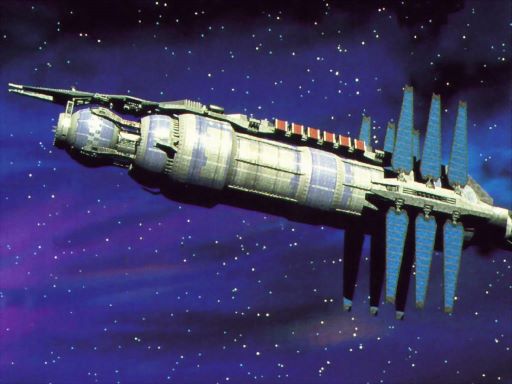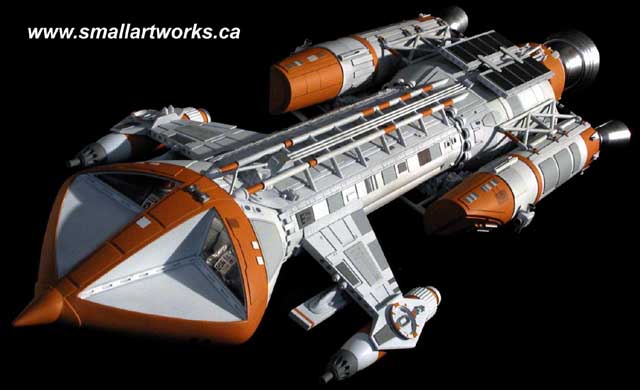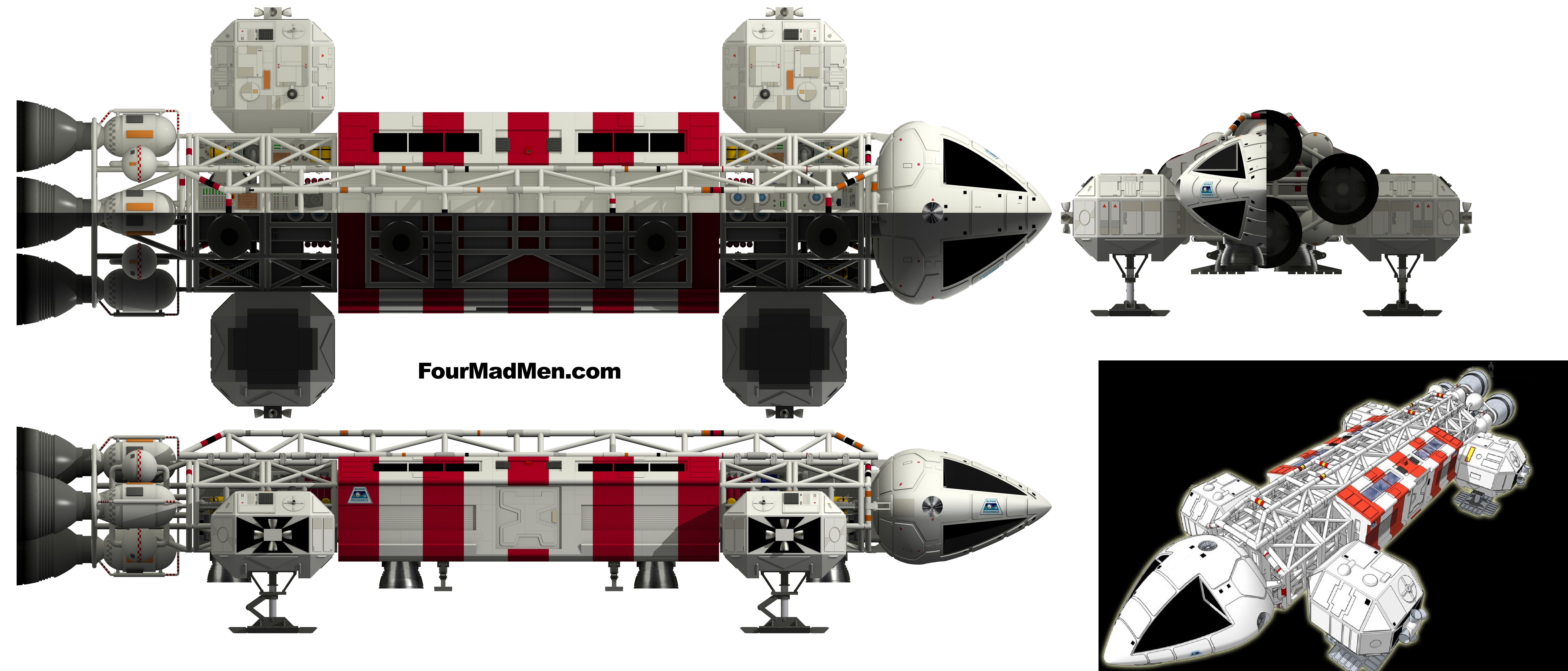 |  | ||||||||||||||||||||||||||||||||||||||||||||||||
|---|---|---|---|---|---|---|---|---|---|---|---|---|---|---|---|---|---|---|---|---|---|---|---|---|---|---|---|---|---|---|---|---|---|---|---|---|---|---|---|---|---|---|---|---|---|---|---|---|---|
The Babylon-Class Governatorial Station needed a basic cargo handling capacity system. The Office Of The State dug around for a cheap, reliable cargo handling system, eventually choosing the Genii designed Vanure-Class ship
Completely modular, the craft are divided into three basic sections: The forward command module (containing the cockpit and related components), the pod module section (amidships), and the engineering space (aft). Around this is the superstructure (containing the landing struts and framework from which the pod module actually 'hangs'). Fuel tanks are located around the ship. The command module of the Eagle can detach from the hull, enabling it to dock with another compatible craft or for use as an emergency escape capsule. (In the VIP variant, the individual pods also double as emergency capsules.) The Eagle-Class are primarily powered by 4 nuclear fusion reactors and propelled by twin tractioning drives with vernier thrust redundancies. The 4 massive thrusters aft are actually decorative; Marketing research revealed that potential passengers in the VIP variant were made uncomfortable by the lack of thrusters. Even having thrusters on the VIP variant but not on the cargo-only variant raised anxiety, so in the end the thrusters were included, complete with blue lights set up to look like thrusters (with steam being ejected, both to obscure the lights enough to complete the deception and to trick viewers into thinking there was actual thrust coming from them). The Eagle-Class also has the capability to enter the atmosphere of a normal-gravity planetary body, landing, and take off again (although standard orbital entry can take up to 24 hours). All standard operations can be run by the craft's on-board computer system, including astronavigation, course correction, evasive maneuvering, etc., but command decisions must still be made by a pilot (except autopilot course maintenance, which requires a pilot to override course corrections and threat deviation). In emergency circumstances, a command code to port with the nearest space station can be transmitted to the ship; If no override is made, the ships will automatically make the transit and unlock the ship's main boarding door. Crew The flight crew (necessary to get a ship from point a to point b) is a Captain (doubling as a pilot) and flight engineer. For an operational mission, however, the minimum crew requirement is Captain (who will take over as pilot only in the event of abandon ship), pilot/XO (who will stay with the captain as co-pilot in event of abandon ship), copilot (in the event of abandon ship, s/he become the rescue crew leader), communications officer (a pilot in training), flight engineer, and cargo Master (passenger chief for a VIP variant). Passengers The VIP variant can carry passengers; The A Model uses 20 Model A Passenger Modules, each capable of holding up to 5 passengers around a central table. The Model A also has a head (toilet and sink only) and a coffee mess. The B Model uses 5 Model B Passenger Modules, each a cabin in its own right with up to 6 racks, a mini-galley, and two full heads (toilet, sink, show). Total passenger space is 30. The C Model is basic transport, typically used for transporting militry/security forces. Special Features Refueling Boom The Eagle-Class is capable of refueling OR being refueled underway. Typically they will refuel another Eagle-Class (buddy fueling), occasionally a Starfury Fighter or Thunderbolt Attacker, though these are usually refueled by a WHITE STAR-Class Corvette (which can also be refueled by an Eagle-Class). Rover Each Eagle-Class freighter comes with 2 GN M-3002 Low-Gravity Vehicle in case of emergency landing on an undeveloped body (including an atmosphereless one). They are often used as duty vehicles on developed bodies. Ship Type: Cargo. Crew (not including connected ships): 6 MDC By Location: | |||||||||||||||||||||||||||||||||||||||||||||||||
| * Hull Small Airlocks/access Hatches (4) Main Airlocks (2) Outer Hull (per 40ft area) Interior bulkheads (per 20ft) | 5,000 250 each 500 each 100 25 | Cargo Pods (all models; 15 total) **Main Engines/Power Plant (2) ** Auxiliary Engines (4) *** Pin Point Barriers (4) | 500 each 12,500 each 6,000 each 5,000 each | ||||||||||||||||||||||||||||||||||||||||||||||
| Notes: * Depleting the MDC of the hull will essentially destroy the vessel. All internal systems will shut down, including life support and internal gravity. The colony ship itself will be an unsalvageable floating wreck, and any surviving colonists must be rescued quickly or will die from asphyxiation as the remaining atmosphere drains into space. ** Depleting the MDC of the main engines will force the ship to rely on its auxiliary engines. Depleting the MDC of the main engines AND auxiliary engines will leave the colony ship adrift in space. If in an atmosphere, the colony ship will crash (destruction of the main engines will render the antigravity system useless due to loss of power). *** The Pinpoint Barriers regenerate at a rate of 1,250 MD per second (2,500 MD per melee round). If destroyed, a barrier will completely regenerate within four seconds (2 melee rounds). Speed and Statistical Data: |  | ||||||||||||||||||||||||||||||||||||||||||||||||
| Speed (sublight): 0.16 speed of light (25,600 miles per second). Speed (Auxiliary Drives): Mach 3. Space Fold: Equipped. Planet Bound: Designed to land in a planetary ocean when necessary but not designed to maneuver in an atmosphere. The Einstein-Class is NOT designed to land on the ground. If it does so the landing will inflict 3D6 times 1000 MD damage to the main body of the spacecraft (the lower sensor spoke will be automatically destroyed). Maximum Range: Unlimited (estimated 30 year life span). Hull Length: 4,101 feet ½ inch (XXm). | Hull Clearance: 4,921 feet 04 inch (XXm). Length (connector/engineering section): 215 m. Weight: Approximately 5.5 billion tons standard. Power System: ORTEC/General Galaxy Main Reactor. Fold System: ORTEC/Shinnakasu/General Galaxy Advanced Fold System Cluster. Sublight Drive: ORTEC/Centinel Impulse Drive Cluster. Gravity Control System: Internal. Auxiliary Engine: Shinnakasu/Shinsei Industries/agar Nuclear Pulse Rocket Motor Cluster. | ||||||||||||||||||||||||||||||||||||||||||||||||
| Weapons Systems: | |||||||||||||||||||||||||||||||||||||||||||||||||
| 1. Pinpoint Barrier Defense System: Originally developed by researchers onboard the SDF-01 MACROSS during the First Robotech War, the Pinpoint Barrier System is a standard defense system on board all UN Spacy starships and colony vessels, including the Einstein colony ships. The system generates four small disc-shaped force fields that can be positioned anywhere along the ship to deflect missiles, energy beams or projectiles. Each pinpoint barrier is about 200 ft (61 m) in length and can absorb up to 5,000 MD in damage, which then regenerates within four seconds (2 melee rounds). The barriers can also be layered on top of each other to generate a field which provides 20,000 MDC and can even deflect heavy particle beams (usually). The four barriers are controlled by operators in the command tower of the carrier. These operators are instructed to defend (1) any breaks or weaknesses in the main hull, (2) the engineering section/battle carrier docking section, and (3) the main and auxiliary engines, in that order. The operators primarily concentrate on defending the ship against larger spacecraft and leave defense against attacking Mecha to the VF pilots from the battle carrier. Purpose: Defense (the pinpoint barrier system cannot be used as a weapon). Range: Up to 300 feet (91.5 m) from the surface of the vessel. MDC: Can sustain up to 5,000 MD per round. Regenerates at a rate of 2,500 MD per melee round. Radius: 200 ft (61 m). Attacks Per Melee: Can move from one end of the vessel to the other in less than a single round. Trained operators can attempt to block attacks up to 8 times per melee (counts as a parry) and are at +7 to block. Untrained characters can parry up to their number of hand-to-hand attacks with their normal parry bonuses only. Payload: Nearly inexhaustible. Will work as long as system is functional (see below) and engines are intact. If main engines are destroyed, the barrier will loose power and not function. Note: If all four barriers are grouped in a single spot they can deflect a heavy particle beam attack, such as the one generated by the Macross Cannon and T'sentraedi command Warships. However, the beam will completely destroy all four barriers and put incredible strain on the pinpoint barrier system, to the point where it may short out. After deflecting an energy beam, roll percentile dice on the table below to determine additional effects/damage. 01-15: Lucked out, system will be operational in 1D6 hours. 16-30: Minor damage, system will require 4D6 hours to repair. 31-45: Major damage, system will require 2D6×10 hours to repair (yes, DAYS of work). 46-60: Completely destroyed! System can be rebuilt, but will require parts and 2D6 DAYS of work to replace. 61-75: Major damage, system will require 2D6×10 hours to repair. 76-90: Minor damage, system will require 4D6 hours to repair. 91-95: Lucked out, system will be operational in 1D6 hours. 96-00: It's a miracle! Trivial damage only, system will be operational again in only 4D6 melee rounds! | 2. Defensive Laser Batteries (20): Each vessel has 20 defensive laser batteries for anti-missile and meteorite defense. MD: 5D6 per blast. Rate of Fire: Per gunners attacks per melee plus bonuses (generally 4 or 5 per melee). Range: 500 feet. Payload: Unlimited. 3. Refueling Boom: The Eagle-Class is capable of refueling OR being refueled underway. Typically they will refuel another Eagle-Class (buddy fueling), occasionally a Starfury Fighter or Thunderbolt Attacker, though these are usually refueled by a WHITE STAR-Class Corvette (which can also be refueled by an Eagle-Class). | ||||||||||||||||||||||||||||||||||||||||||||||||
| Features: | |||||||||||||||||||||||||||||||||||||||||||||||||
